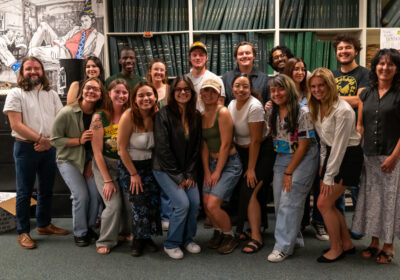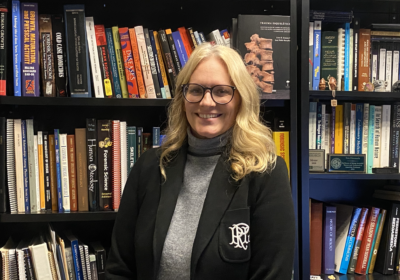Novel suggestions for November
November is not just a month for eating turkey and growing a beard. This month is also known as National Write a Novel Month to celebrate aspiring writers working their fingers diligently to crank out the next great piece of literature.
The Oracle staff has compiled a list of some of our most recommended novels to help inspire the next generation of Sylvia Plaths and Ernest Hemingways.
“Alice’s Adventures in Wonderland” by Lewis Carroll – 1865
It’s a story known for its utter nonsense and mind-numbing riddles, but hidden in Lewis Carroll’s “Alice’s Adventures in Wonderland” is a simple truth – “we’re all mad”
Wonderland has enraptured both the young and young at heart for centuries with its ethereal portrayal of childhood wonder. A story that exposes new truth at every stage in life, it allows readers to come away with a new understanding of the world and gives the OK to be confused by it.
College students can often feel as though they are falling down Alice’s rabbit hole, unable to control or understand the world around them and slowly going mad in the process. But Carroll shows us that the world is not meant to be understood. Life is a wonderland, filled with puzzles that have no correct answer. It’s up to us to follow Alice’s example and confront life head-on, creating our own truths amid the chaos.
Ultimately, Carroll’s classic bedtime story is a celebration of life and all its eccentricities. The world, just like its inhabitants, is always changing, but that’s what makes it beautiful.
– Anastasia Dawson, Editor-in-Chief
“The Sun Also Rises” by Ernest Hemingway – 1926
“The Sun Also Rises” resonates as both a love story between the war-ravaged main character, Jake Barnes, and the lovely Lady Brett Ashley, and a proclamation that the “lost generation” is not as damaged by World War I as most would believe.
Throughout the novel, Hemingway explores love, death, renewal in nature and the nature of masculinity by his use of stream of consciousness, a typical narrative mode found in Hemingway novels.
This, coupled with his descriptions of caf life in Paris and the excitement of the Pamplona festival in Spain, presents a tale that is alluring in its detail.
– Brittany Cerny, Copy Editor
“Raise the Titanic!” by Clive Cussler – 1976
Clive Cussler is considered the “grandmaster” of the thriller genre. With more than 17 consecutive novels on the New York Times’ bestsellers list, it makes it hard to choose a favorite. My pick is his breakout thriller, “Raise the Titantic!”
This novel presents readers with an outlandish plot of a quest to raise the Titanic from the bottom of the ocean. Subtle techniques help the reader fall in love with the daring search for the sunken ship which, at the time the novel was written, hadn’t been found.
The protagonist, Dirk Pitt, is to maritime exploration what James Bond is to international espionage. Readers will enjoy his slick, laid-back personality.
Pitt is a good, old-fashioned American who “believes in the national anthem, baseball and the American way.” Pitt keeps readers on the edge of their seats, but this is not a mindless thriller. My favorite quote from the novel: “There is a touch of Dirk Pitt in everyone who longs for adventure, and because he is Dirk Pitt, he longs for it more than the rest.”
– Thomas Fernandez, Account Executive
“White Noise” by Don DeLillo – 1985
This book doubles as a concrete story of a postmodern family and an abstract satire of popular culture. The plot follows a university professor named Jack who has established a bizarre educational niche, forming his own “department of Hitler studies.”
His colleague, Murray, is obsessed with the psychic energy of the supermarket. His children though very young, talk like adults and seem smarter than the scholarly protagonist.
DeLillo comments on American consumerism, crises of identity and the universal fear of death with subtle, often dark, humor. “White Noise” dances back and forth across the line separating scenes of real and surreal events, providing for an entertaining and intellectually stimulating read.
– Joe Polito, Montage Editor
“Salad Days” by Charles Romalotti – 2000
College offers an opportunity to read the entire works of classic, well-loved authors – Vonnegut, Dostoevsky and Nabokov – but also to discover fantastic, more obscure novels such as Charles Romalotti’s “Salad Days.”
The plot follows Frank, a punk living in Kansas who gets the chance to front his favorite band and tour with them.
Though occasionally crude in its writing and subject matter, the book remains insightful about the social structures inside and outside the punk community while effortlessly weaving in bands such as Descendents and Bad Brains into its narrative.
Romalotti is not necessarily this generation’s great author – most of his other releases are horror books with dubious-looking covers – but “Salad Days” is a fantastically funny, poignant, everything-but-the-kitchen-sink novel highly recommended even to non-fans of punk music.
– Jimmy Geurts, Managing Editor
“Eragon” by Christopher Paolini – 2002
Maybe “Eragon” is only my favorite book because it came out when I was 13, but it’s still my favorite novel.
The first book in a series about dragons appeals to the average boy. Besides dragons, there are elves, dwarves, swords and magic. What’s not to like?
It helps, too, that the author, Christopher Paolini, was only 15 years old when he started writing the series. It makes it easier to relate to because the author and title character are near the same age.
The follow-ups in the original trilogy, “Eldest” and “Brisingr,” are just as good, but every good series starts with the first book.
– Michael Manganello, Sports Editor







